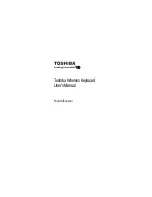
KARMA GE guide
940
Dotted Rhythms
[0…8]
Selects a value for the “Rhythm Value” parameter from
a subset of the entire range. The subset consists of the
dotted values along with
0: None
and
8: Rhythm
Pattern
. This is used to provide real-time control of the
“Rhythm Value” parameter while excluding certain of
the in-between values.
Triplet Rhythms
[0…8]
Selects a setting for the “Rhythm Value” parameter
from a subset of the entire range. The subset consists of
the triplet values along with
0: None
and
8: Rhythm
Pattern
. This is used to provide real-time control of the
“Rhythm Value” parameter while excluding certain of
the in-between values.
Selected Rhythms
[0…13]
Same as “Straight Rhythm Values,” except adds the
two most musically useful dotted values also.
Selected Rhythms2
[0…18]
Specially created for Drum GEs, providing the same
subset as Selected Rhythm Values (above), with the
addition of the most useful short note values.
Use Swing
[0, 1]
Sets whether the repeated notes will take on the swing
feel that is set in the Rhythm Group. If
0: Off
, the
generated notes may be swung but the repeated notes
will not be. Note that triplet rhythm values are not
affected by swing.
When the Rhythm Group “Swing %” parameter
(
0
, this parameter has no effect.
Time Offset (ms)
[–127…+127]
Allows a positive or negative millisecond offset to be
applied to very short repeat times, making them
slightly shorter or longer. One use is to “tune” to a
certain key resonant delay effects created with short
repeat times.
Only operable when one of the first three settings of
the Rhythm menu are selected (None, 64th triplet,
or 64th). For example, you can use it to adjust a
short Rhythm setting, and then switch to a longer
setting via GE RT Parameter control, and the offset
will be ignored, allowing the longer rhythms to stay
in sync.
Repetitions
[0…100, 101:
]
The maximum number of repeated notes to generate.
Note that due to other settings and circumstances, not
all of them may actually be generated. A setting of
101:
causes the notes to repeat indefinitely, unless
something else stops them.
Decay
[–126…+126]
The amount by which each successive repeated note
changes in velocity.
Negative numbers
cause the
delayed notes to decrease in volume (more common),
while
positive numbers
cause the delayed notes to
increase in volume. Interesting effects can be created
by a combination of a
high negative
“Initial Velocity”
(i.e.
-120
) and a
small positive
“Decay” (i.e.
+4
). Note
that this operates in conjunction with the Velocity
Pattern specified in the Velocity Group.
Initial Velocity
[–126…+126]
The velocity above or below the original note that the
first repeated note is generated at, after which the
“Decay” parameter is added to them with each
successive repetition. Note that this operates in
conjunction with the Velocity Pattern specified in the
Velocity Group.
Transpose
[–24…25]
The amount by which each successive repeated note is
transposed in pitch. When one of the semitone values
is selected, the same value is used for each repeated
note. When the Pattern option is selected, the
25: Index
Pattern
in the Index Group is used, so that each
repeated note can transpose a different amount from
the previous repeated note. Depending on the input
notes, anything other than 0 or multiples of
12
may
produce atonal results; these can be shifted to tonal
results using “Chord Shift,” described below.
Chord Shift
[0…2]
When repeated notes are being transposed in pitch,
atonal results may occur depending on the
“Transpose” setting. When “Chord Shift” is
0: Off
, no
change occurs in the transposition. Setting “Chord
Shift” to
1: Scalic
or
2: Scalic2
causes chord recognition
0: None (Instant)
3: 16th Dotted
6: Half Dotted
1: 64th Dotted
4: 8th Dotted
7: Whole Dotted
2: 32nd Dotted
5: Quarter Dotted
8: Rhythm Pattern
0: None (Instant)
3: 16th Triplet
6: Half Triplet
1: 64th Triplet
4: 8th Triplet
7: Whole Triplet
2: 32nd Triplet
5: Quarter Triplet
8: Rhythm Pattern
0: None (Instant)
5: 8th Dotted
10: 2 Wholes
1: 64th
6: Quarter
11: 3 Wholes
2: 32nd
7: Quarter Dotted
12: 4 Wholes
3: 16th
8: Half
13: Rhythm Pattern
4: 8th
9: Whole
0: None (Instant)
7: 16th
14: Whole
1: 64th Triplet
8: 8th Triplet
15: 2 Wholes
2: 64tht
9: 8th
16: 3 Wholes
3: 64th Dotted
10: 8th Dotted
17: 4 Wholes
4: 32nd Triplet
11: Quarter
18: Rhythm Pattern
5: 32nd
12: Quarter Dotted
6: 16th Triplet
13: Half
0: Off
1: On
–24…24: –24…+24 semi-tones
25: Index Pattern
0: Off
1: Scalic
2: Scalic2
Содержание Electronic Keyboard
Страница 1: ...Parameter Guide Parameter Guide ...
Страница 2: ......
Страница 180: ...Program mode EXi 170 ...
Страница 290: ...EXi STR 1 Plucked String 280 ...
Страница 572: ...Sequencer mode 562 ...
Страница 700: ...Global mode 690 ...
Страница 751: ...Insert Effects IFX1 IFX12 Routing 741 Fig 2 3a Fig 2 3b ...
Страница 902: ...Effect Guide 892 ...
















































